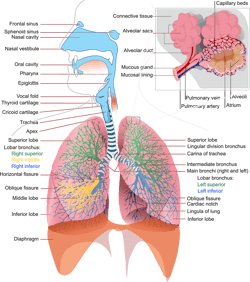Unexpected biochemical pathway triggered in lung cells by COVID-19
An international team of researchers unexpectedly found that a biochemical pathway, known as the immune complement system, is triggered in lung cells by the SARS-CoV-2 virus, which might explain why COVID-19 is so difficult to treat. The research is published this week in the journal Science Immunology, according to a news release from Purdue University.
The researchers propose that the pairing of antiviral drugs with drugs that inhibit this process may be more effective. Using an in vitro model using human lung cells, they found that the antiviral drug Remdesivir, in combination with the drug Ruxolitinib, inhibited this complement response.
This is despite recent evidence that trials of using Ruxolitinib alone to treat COVID-19 have not been promising.
To identify possible drug targets, Majid Kazemian, Assistant Professor in the Departments of Computer Science and Biochemistry at Purdue University, said the research team examined more than 1,600 previously FDA-approved drugs with known targets.
“We looked at the genes that are up-regulated by COVID-19 but down-regulated by specific drugs, and Ruxolitinib was the top drug with that property,” he said.
Within the last few years, scientists have discovered that the immune complement system – a complex system of small proteins produced by the liver that aids, or complements, the body’s antibodies in the fight against blood-borne pathogens – can work inside cells and not just in the bloodstream.
Surprisingly, the study found that this response is triggered in cells of the small structures in the lungs known as alveoli, Kazemian said. “We observed that SARS-CoV2 infection of these lung cells causes expression of an activated complement system in an unprecedented way.”
“We observed that SARS-CoV2 infection of these lung cells causes expression of an activated complement system in an unprecedented way,” Kazemian said. “This was completely unexpected to us because we were not thinking about activation of this system inside the cells, or at least not lung cells. We typically think of the complement source as the liver.”
Ben Afzali, an Earl Stadtman Investigator of the National Institute of Health’s National Institute of Diabetes and Digestive and Kidney Diseases, said there are now indications that this has implications for difficulties in treating COVID-19.
“These findings provide important evidence showing not only that complement-related genes are amongst the most significant pathways induced by SARS-CoV2 in infected cells, but also that activation of complement occurs inside of lung epithelial cells, i.e., locally where infection is present,” he said.
“This may explain why targeting the complement system outside of cells and in the circulation has, in general, been disappointing in COVID-19. We should probably consider using inhibitors of complement gene transcription or complement protein activation that are cell permeable and act intracellularly instead.”

